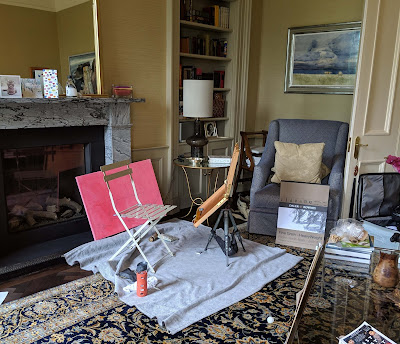My Edinburgh portrait is finished. Now I can head to Iona and some plein air, once again in the footsteps of the Scottish Colourists.
 |
|
The Golden Hour, Carol L. Douglas. This isn’t a perfect photo, but is the best I could do at the time.
|
In some ways you might have found the execution of this painting brutally workmanlike. There was no flailing or fits of self-discovery; I save those for my own studio.
I started on Wednesday of last week. I laid down my brushes for the final time at 4:26 PM yesterday. That was exactly four minutes before I’d agreed to finish. Most of those days, I worked strictly from 9 to 5. The exception was Tuesday, when I overran my hours and worked until after sunset. But that wasn’t panic-painting; I simply needed more time for Poppy (the dog), who hadn’t figured in my original plan.
The client stated up front that he wouldn’t look at the painting until it was done. Indeed, he carefully averted his eyes whenever he entered the drawing room.
 |
|
My worksite.
|
His only request was that the painting be in the manner of Francis Cadell. I studied a number of Cadell paintings over the winter. Once I entered the drawing room, however, I resolutely looked at no other paintings, except the James Morrisonlandscape peering over my shoulder. Morrison’s a terrific modern Scottish landscape painter and there are two of his paintings in this townhouse. It was a unique opportunity to study his work closely.
 |
|
Interior with opera cloak, date unknown, Francis Cadell, courtesy Portland Gallery. This was painted just a few doors down from this townhouse.
|
I did see one Cadell painting at the preview for Bonhams’ Scottish Sale. But otherwise, I cloistered myself from other painters for the duration. Studying art while in the midst of an important painting muddies my vision.
We’d planned an unveiling for 4:30 yesterday. Yesterday, my client chipped a tooth and needed emergency dental work. By the time he came back, I’d cleaned up my kit and we’d returned the drawing room furniture to its usual places. He looked at the painting, made a brief, eloquent, and complimentary speech, and then turned back to spend more time with the piece. I can’t remember a word he said, but the model was happy, the patron engaged with the painting, and I breathed a great sigh of relief.
 |
|
My client inspecting the finished work.
|
Someone asked me how I was able to estimate my time so precisely. Part of that comes from painting for a long time. I’m pretty certain how long it takes to finish a canvas. But part of that is also confidence—not in my own abilities, but in God. “Which of you fathers, if your son asks for a fish, will give him a snake instead?” Jesus famously asked. I get up every morning knowing that the God who has brought me this far intends to carry me through. That saves me a lot of worry and self-doubt.
I’m off to Ionain two hours and still have not packed. I first visited this island in 2016. Since then I’ve longed to return and paint its white sands and tropical aquamarine waters. This takes me, once again, in the footsteps of the Scottish Colourists. Here Cadell worked in a much looser style, as befits plein air, but on Iona I anticipate working in the manner of nobody but myself.





